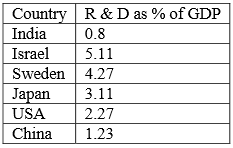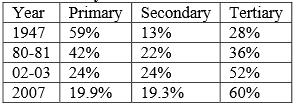As can be seen from Table 4 in 1991, India was at ninth position with 2.4% of share in Global Scientific Publication whereas China ha d only 0.9% share. By 2005, India completely lost its position of eminence in Scientific Publication whereas China had a meteoric rise surging forward to 5 th position with 7.5% share in Global Publication. The same above studies have also shown that Wealth Intensity (= Total GDP/Total Population) is strongly correlated to Citation Intensity(= Total Citations/GDP) and citation intensity is a direct measure of knowledge wealth. See Figure 1. Hence physical prosperity and social well being is directly dependent on our citation intensity. 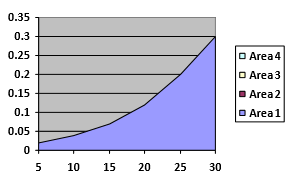
Figure 1. National Science Citation Intensity(y axis) vs Wealth Intensity (x-axis).
Table 6. Nations, their citation intensity and wealth intensity. 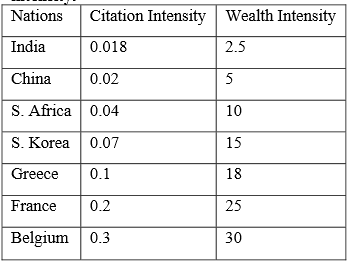
6 th January 2010, New Scientist carries an article “ Get ready for China’s domination of Science”. Based on the article we obtain the following Table 7. Table 7. Research Publicat ions of China in last one decade. 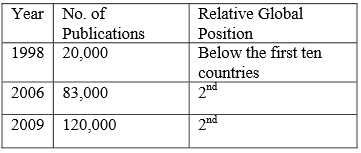
Table 9. Allocation of p ercentage GDP in Education, Higher Education and Science Higher Education.
(The Hindu, 2007) 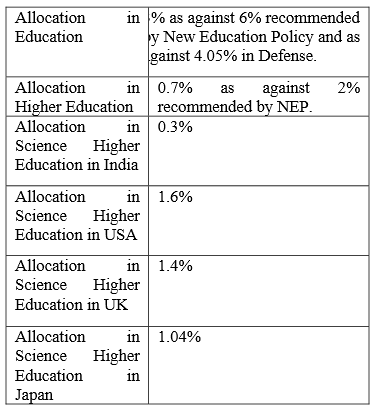
We have a huge technically trained personnels. We are producing 400,000 Engineering Graduates per year, 300,000 Computer Science Graduates per year, 20,000 MTechs per year and fewer than 1000 PhDs in engineering per year. Most of the Scientific and Technical personnels are going into job market leaving us with a huge deficit of Rese archers and Faculty for our Higher Education.
Table 10. Researchers per million of population in India, China and USA in 2007-08 (The Hindu, November 13, 2009) 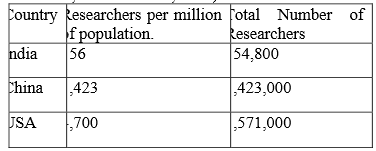
A survey of 47 Universities conducted by UGC in 2007- 08 revealed that 50% of sanctioned faculty positions were vacant. There are not enough PhDs to meet the faculty requirement of the Universities. As a result over the years the quality of faculty has shown declining trend. A study by I.I.T., Bombay shows that there will a severe shortage of teacher for Technical Institutes including IITs and NITs in coming years. There will be a shortage of 93,000 teachers by 2012 and a shortage of 1.84 lakhs by 2017. This shortage is primarily due to the fact that w students in their basic design work of engineering problems.
6. Faculty members contri bution at NIT,Patna.
Here at NIT, Patna, two faculty members participated in Indo-US Collaboration Program in Engineering Education in Summer 2009. Subsequent to this participation, we always keep in mind the slogan “ We are teaching but are our students learning ? ”. With this slogan in mind we have increased the quiz tests in theory as well as in Laboratories. We are using the Management Information System Intranet to conduct regular On-Line class quizzes. These On-Line quizzes require a large data-set which we are building bit by bit. The Class Note materials of EC1505_Analog Electronics theory and tutorial materials have been uploaded on http://cnx.org . All the class notes along with figures, diagrams and tables are available for ready reference by the students. The tutorial upload has exposed the students to the full spectrum of questions and design problems on the topics covered in the cl ass. The on-line quizzes will motivate the students to do the tutorial exercises on their own. The Practical Laboratory Cla sses have been remodeled to make it stimulating, thought provoking and challenging. The direct participation of students in bread-board kind design experiments helps develop a better grasp of the subject matter. The impact of these innovative methods are yet to be seen. A test has to be devised to quantify the true learning process. Once such a test method is developed we can measure the impact of these innovative methods.
Conclusions.
We have seen that after Independence much has been achieved in some specific fields of Science & Technology such as Space, Atomic Power Plants, Telecommunication and Software Development but in general due to lack of Knowledge Wealth Generation our Industries both in Private & Public Sector are heavily dependent on borrowed technology. The low Citation Intensity has led to low Wealth Intensity. The low Citation Intensity is indicative of poor scientific enquiry and scientific quest and the root of this problem lies in school education where the children inquisitiveness is not nurtured and developed. The Policy Makers will have to device a system of school education whereby the spirit of enquiry becomes a lif e long quest. Meanwhile we have to do our bit as responsible faculty members of Engineering Colleges. We have to make our delivery of subject matter more rigorous and thoroughgoing so that students develop a command over the subject matter they are taught. |
|
Increasingly China is doing collaborative research with other advanced countries such as US, UK, Taiwan and Singapore. These collaborations are being done on equal footing. Capacity for Research and Production is being built up. Expatriates from foreign countries are being attracted for full indigenous development. These foreign returned Scientists are being given free hand to develop things in a manner they think best. China is engaged in Frontline Research specifically Stem Cell Research and Nano Technology Research. In Stem Cell Research they have been able to develop Pluripotent- induced-Stem Cells. In 2009, Chinese scientists managed to develop Pluripotent-induced-Stem Cells from the skin cells and produced two generations of mice-clones. China has 5000 researchers and 600 companies. China has been able to make fastest bullet trains operational from Wuhan to Guangzhou over a distance of 1070km . The journey time is 2 hours 45 minutes. Chinese Government is determined to reverse the brain drain and it is achieving it by infusing national pride in the expatriates and by creating a conducive atmosphere back at home. The Gross Expenditure on R&D in China has been increasing at an annual rate of 18% for last one decade and today it stands at third position in GERD just behind US and Japan and ahead of all European Nations.
3. The causes of sharp deterioration in our Scientific Quest.
In recent years there has been a definite deterioration in the quality of our Scientific Research and the causes are not far to seek. Table 7. Investment per student in 1950 and 2000 at 1990 prices. (The Hindu, 2007) 
Table 8. Students opting for Science Education in 1950 and 2007. (The Hindu, 2007)

are not able to attract suffi cient number of students for our M.Tech and Ph. D programmes. Defense has gobbled away our precious resources leaving little for Education and Health Care. From Table 7, 8 and 9 it is evident that quality of Science Education all over India has drastically deteriorated from school level to Post Graduate level. Establishment of IITs and NITs do not help the matter. Most of the ablest and best prepared students are opting for Professional Courses like Engineering, Medical and Business Administration and even those opting for Professional Courses are not aiming at Research but on private co nsultancies because that is what he sees around. All these changes in basic value system has taken a heavy toll on our basic and development researches.
4. Remedies for the present Research Scenario.
What is today required is a sincere soul searching by our Government regarding our high school education system. The spirit of enquiry and the quest of knowledge is basic to every child. In fact it is his nature but his training through primary and secondary school completely extinguishes this enquiry and quest. All people concerned- Government, Academicians and Teachers have to come together and work out a system whereby the basic urge of enquiry and discovery is kept alive through his school days. It is this ground work which will eventually turn around the scenario in Universities and Institutes of National Importance and pay us back rich dividends in terms of improved citation intensity which will in turn help improve the wealthy intensity of our Nation. In foreign lands most of the billionaires have dedicated large sum of their wealth towards Research Foundations such as Howard Hughes Foundation, Rockfeller Foundation, Packard Foundation, MacArthur Foundation and Bill Gates Foundation. We also have 52 billionaires but we have one Research Foundation created by Infosys. Govt must take initiative to motivate these billionaires to create the Research Foundations in their respective fields.
5. Faculty Role in Engineering Colleges. Once the problem of Research Scenario has been put in perspective and while the soul – searching is going on among our Policy Makers, we the faculty members at Engineering Colleges have some urgent tasks begging our attention. We must make our course material interesting and engaging. For this the course material must be made simple, basics must be clarified and all the course material must be readily available and accessible through the library, text books, reference books and through on-line materials. Next we must make our Laboratory Work stimulating and challenging and encourage individual or small groups in the Laboratory Experiments. This will help increase the participation of
References.
Glanzel,W., Debackere, K. &Meyer,M. (2008)“ Triad or Tetrad ? On Global Change s in a dynamic world,” Scientometrics , Vol 74, No 1 (2008), pp 71-88 Kalwa, P. & Jain, S. ,(2009) , “Trends in National Income since 1941” , Chapter 4, Page 69, Table 4.2, 2009 King, D.(2004) “Scientific Impact of Nations,” Nature , July 15, (2004), Volume 430, pp.311-316 ; May, R. M. ,(1997) “ The Scie ntific Wealth of Nations”, Science , 7 February,(1997) Vol. 275, No. 5301, pp. 793- 796; The Hindu , (2007) “Sixty Years of higher education”, The Hindu, August 11 (Saturday), 2007 The Hindu, (2009), Narayana Murthy, N.R., “Securing India’s Science Future,” The Hindu, November 13 (Friday), 200 |



